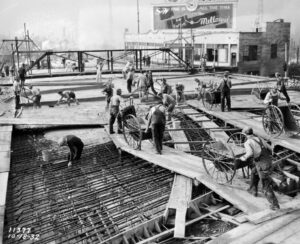The Matter Of Safety In The History Of The Construction Industry
By Joe Egan, Contributor
 The construction industry is one of the oldest activities created by human beings. It started at the beginning of mankind thousands of years ago when we developed the ability to reason: the cognitive ability to draw a conclusion based on the experience or use of tools or other available material. With such new brainpower, the conscious early man reasoned that rocks could be transformed and used as a tool and thus built the first condominiums, then called caves.
The construction industry is one of the oldest activities created by human beings. It started at the beginning of mankind thousands of years ago when we developed the ability to reason: the cognitive ability to draw a conclusion based on the experience or use of tools or other available material. With such new brainpower, the conscious early man reasoned that rocks could be transformed and used as a tool and thus built the first condominiums, then called caves.
Ever since, construction has been a reflection of a society’s technology and values. We know that much has changed and much has not. Tools, equipment, knowledge, and the considerations for safety are in a constant state of change. There have been major leaps in technology. Slide rules have been replaced by calculators. Blueprints have been replaced by computer-aided design (CAD) and building information modeling (BIM). The plumb bob and tape measure have been replaced by laser beams.
Safety has advanced from being a low priority to a primary concern. The Federal Occupational Safety and Health Act was not signed into law until 1970 and many contractors considered some rules just a burdensome cost increase. Prior to OSHA, construction companies and employees were on their own regarding the importance and practice of safety. Today, successful companies don’t treat their safety representative as a detective who exposes dangerous conditions and scolds workers. Instead, the position is high on the organization chart because of the respect they have earned and the realization that safety is about affecting human behavior in the wise (safe) or unwise (dangerous) decisions that are made.
Words to win by for a successful culture and practice of safety
- Attitude about safety is a matter of personal choice. It is the key that either locks success away from you or opens it up to you.
- Leadership cannot be faked or granted; it is earned and based on the ability to inspire willing
- Rely on hope to show your potential, but also realize that hope itself is not a reliable strategic plan.
- Hard work is not a guarantee of result, just as education is not a guarantee of wisdom
- Honesty is external truth-telling and the internal willingness to recognize your strengths and weaknesses
- Behavior is a function of your decisions, not your conditions.
- Problem solvers look for answers, not errors.
- If you can control the solution, you can control the problem.
Joe Egan is President of Egan Connection Inc., a construction consulting, coaching, and training company, and also President of Egan Publications Inc. for the authorship and publication of his three books: (1)The General Contractor – How to be a Great Success or Failure (2) Construction Project Management – How the Great Ones do it and (3) Building Positive Character – 50 Tips on Empowerment, Overcoming and Success. Egan is also an adjunct professor at Minnesota State University School of Construction Management.



